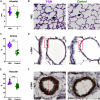Long-term pulmonary and neurodevelopmental impairment in a fetal growth restriction rabbit model
- PMID: 38017239
- PMCID: PMC10684490
- DOI: 10.1038/s41598-023-48174-6
Long-term pulmonary and neurodevelopmental impairment in a fetal growth restriction rabbit model
Abstract
Fetal growth restriction (FGR) remains one of the main obstetrical problems worldwide, with consequences beyond perinatal life. Animal models with developmental and structural similarities to the human are essential to understand FGR long-term consequences and design novel therapeutic strategies aimed at preventing or ameliorating them. Herein, we described the long-term consequences of FGR in pulmonary function, structure, and gene expression, and characterized neurodevelopmental sequelae up to preadolescence in a rabbit model. FGR was induced at gestational day 25 by surgically reducing placental blood supply in one uterine horn, leaving the contralateral horn as internal control. Neonatal rabbits born near term were assigned to foster care in mixed groups until postnatal day (PND) 21. At that time, one group underwent pulmonary biomechanical testing followed by lung morphometry and gene expression analysis. A second group underwent longitudinal neurobehavioral assessment until PND 60 followed by brain harvesting for multiregional oligodendrocyte and microglia quantification. FGR was associated with impaired pulmonary function and lung development at PND 21. FGR rabbits had higher respiratory resistance and altered parenchymal biomechanical properties in the lungs. FGR lungs presented thicker alveolar septal walls and reduced alveolar space. Furthermore, the airway smooth muscle content was increased, and the tunica media of the intra-acinar pulmonary arteries was thicker. In addition, FGR was associated with anxiety-like behavior, impaired memory and attention, and lower oligodendrocyte proportion in the frontal cortex and white matter. In conclusion, we documented and characterized the detrimental pulmonary function and structural changes after FGR, independent of prematurity, and beyond the neonatal period for the first time in the rabbit model, and describe the oligodendrocyte alteration in pre-adolescent rabbit brains. This characterization will allow researchers to develop and test therapies to treat FGR and prevent its sequelae.
© 2023. The Author(s).
Conflict of interest statement
The authors declare no competing interests.
Figures





Similar articles
-
Fetal Growth Restriction Impairs Lung Function and Neurodevelopment in an Early Preterm Rabbit Model.Biomedicines. 2023 Jan 5;11(1):139. doi: 10.3390/biomedicines11010139. Biomedicines. 2023. PMID: 36672647 Free PMC article.
-
Placental vascular alterations are associated with early neurodevelopmental and pulmonary impairment in the rabbit fetal growth restriction model.Sci Rep. 2022 Nov 16;12(1):19720. doi: 10.1038/s41598-022-22895-6. Sci Rep. 2022. PMID: 36385147 Free PMC article.
-
Fetal growth restriction and intra-uterine growth restriction: guidelines for clinical practice from the French College of Gynaecologists and Obstetricians.Eur J Obstet Gynecol Reprod Biol. 2015 Oct;193:10-8. doi: 10.1016/j.ejogrb.2015.06.021. Epub 2015 Jul 2. Eur J Obstet Gynecol Reprod Biol. 2015. PMID: 26207980
-
Fetal growth restriction and neonatal-pediatric lung diseases: Vascular mechanistic links and therapeutic directions.Paediatr Respir Rev. 2022 Dec;44:19-30. doi: 10.1016/j.prrv.2022.09.002. Epub 2022 Oct 11. Paediatr Respir Rev. 2022. PMID: 36503648 Review.
-
Paediatric consequences of fetal growth restriction.Semin Fetal Neonatal Med. 2004 Oct;9(5):411-8. doi: 10.1016/j.siny.2004.03.005. Semin Fetal Neonatal Med. 2004. PMID: 15691777 Review.
Cited by
-
Leptin deficiency, a potential mechanism for impaired fetal lung development in uteroplacental insufficiency?Pediatr Res. 2024 May;95(6):1410-1411. doi: 10.1038/s41390-024-03038-1. Epub 2024 Jan 23. Pediatr Res. 2024. PMID: 38263448
References
MeSH terms
Grants and funding
LinkOut - more resources
Full Text Sources
Miscellaneous

